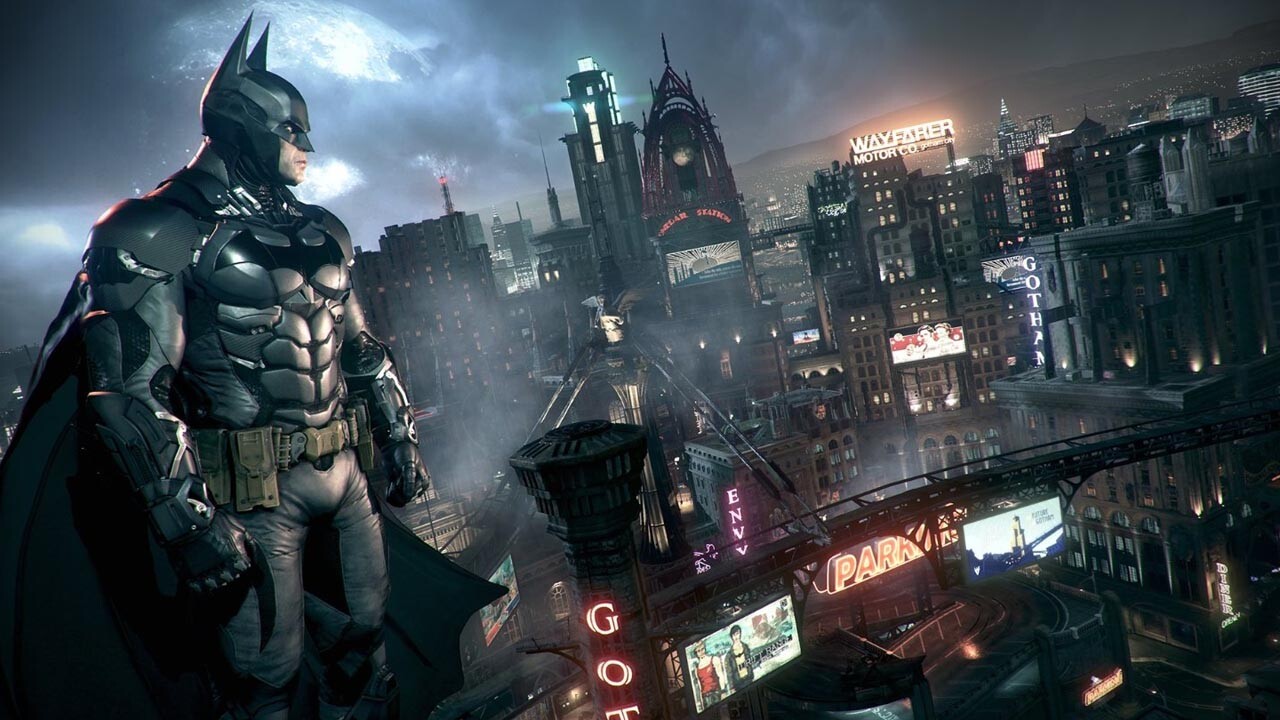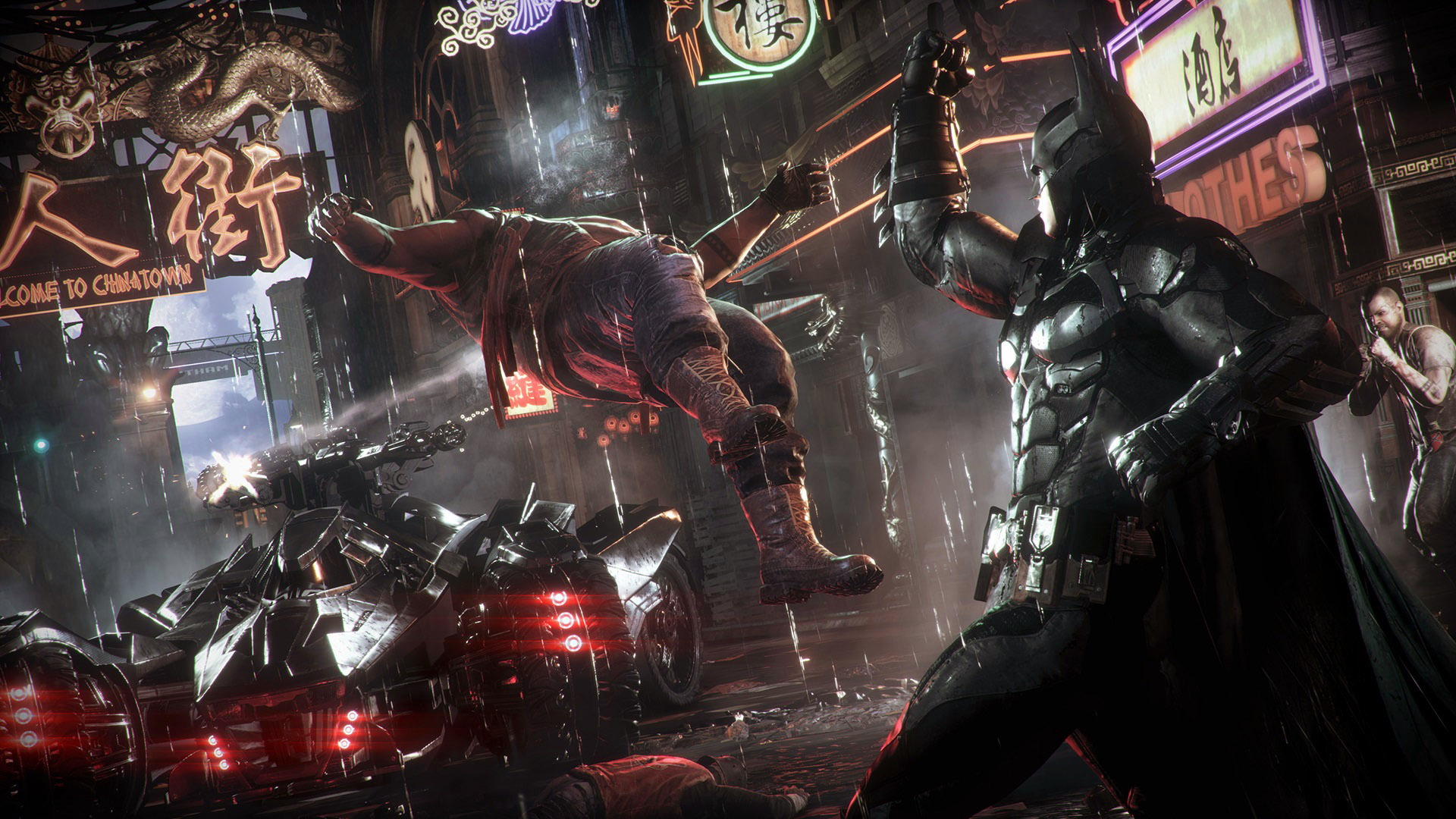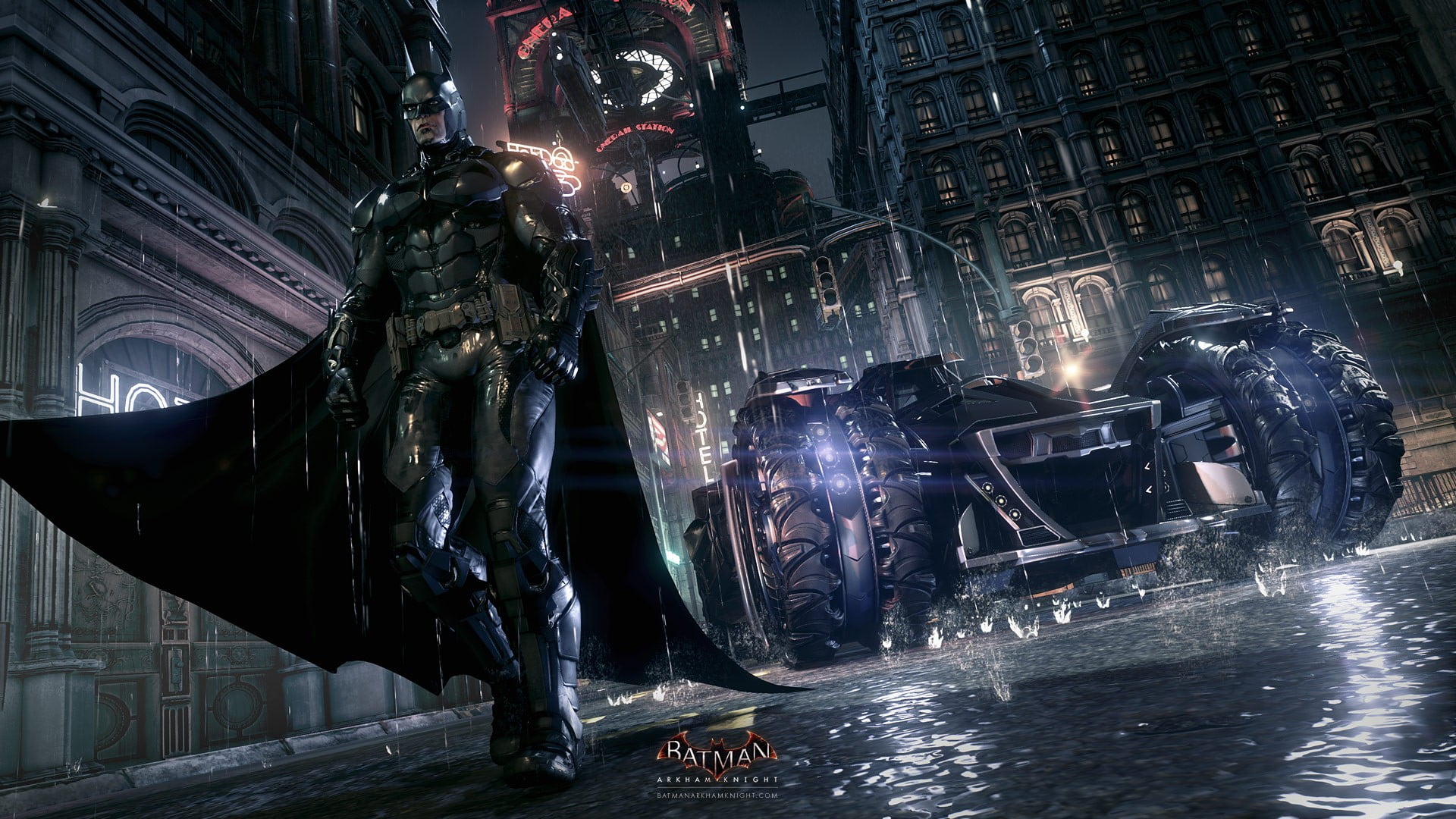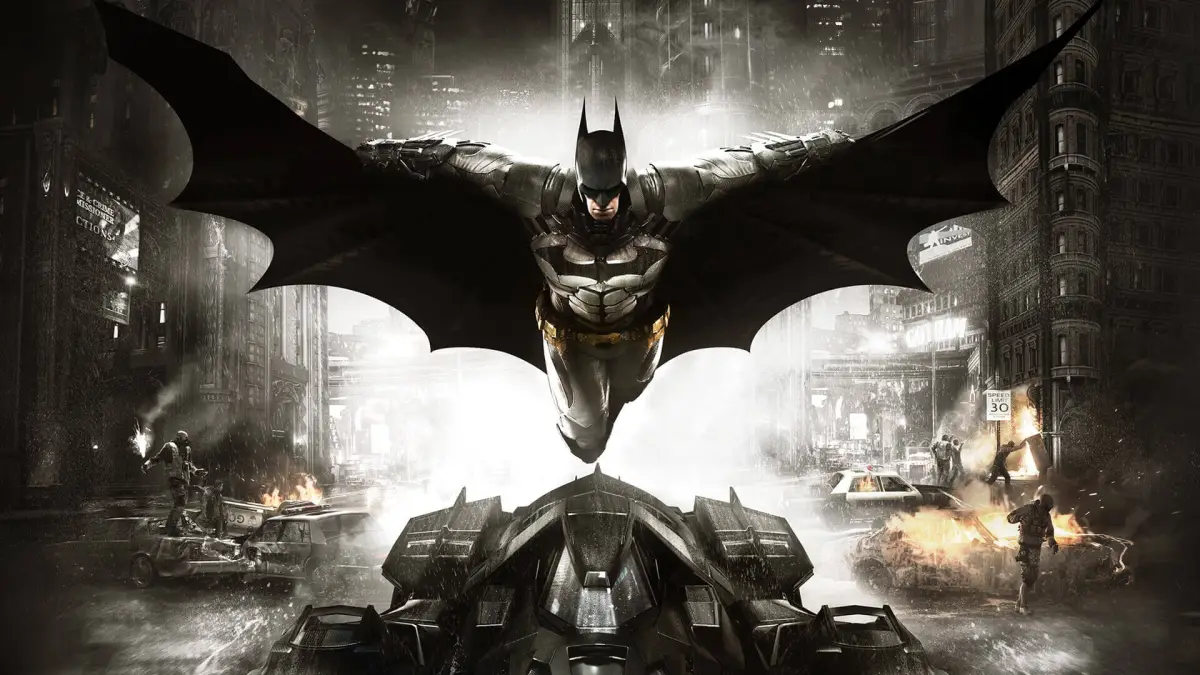Spoilers ahead for Rocksteady’s Arkham Asylum, Arkham City, and Arkham Knight.
The inevitability of death permeates Batman: Arkham Knight, the final game in Rocksteady’s Batman: Arkham trilogy. The game opens with the cremation of the Joker’s (Mark Hamill) body, following his death at the end of Batman: Arkham City. Jim Gordon’s (Jonathan Banks) opening monologue warns the player, “This is how it happened. This is how the Batman died.” However, Arkham Knight doesn’t just build to Batman’s (Kevin Conroy) death. It seems to argue for the necessity of it.
The Arkham games are predicated on the idea of insanity as something that spreads and grows; something that is inherently expansive. In the first game in the series, Arkham Asylum, the madness is contained. Even spilling out from the eponymous institution, it only really takes hold of an island in Gotham Bay. In Arkham City, the madness has consumed an entire city suburb, locked in by an armed force and a high wall. However, by Arkham Knight, that insanity has consumed all of Gotham.
Part of this is just scope creep. In order to justify the sequels, Rocksteady needs to escalate and diversify the gameplay arena. The marketing for Arkham City boasted that its play area was five times the size of Arkham Asylum, and Arkham Knight was then “five times larger” than Arkham City. That’s just how the industry works, and it’s genuinely breathtaking to consider how quaint Arkham Asylum seems in hindsight. However, this also feels like something of a bigger thematic statement.
The Arkham games place the player in Batman’s perspective, asking them to imagine what it must feel like to be the Caped Crusader. The necessity of Batman is core to this idea. After all, there is something inherently unsettling in the idea of a billionaire who takes it upon himself to enforce law and order in a major urban city while dressed as a giant bat. In order for Bruce Wayne to seem at all heroic, the world needs to be fundamentally broken. More than that, it needs to be insane. The whole world becomes an asylum.
While divisive among more hardcore fans of the character, there is a reason that Frank Miller’s take on the character has endured, why books like Batman: Year One and The Dark Knight Returns remain touchstones more than three decades after they were first published. These stories understand the logic necessary for Bruce to justify his vigilantism. He needs to believe that “the world only makes sense when you force it to.” The Arkham games understand that, to fully capture Bruce’s perspective, the player needs to believe it too.

So the arc of the Arkham trilogy is the story of Batman as a man desperately trying to function as the last bulwark of sanity in a world where madness is spreading and expanding, where it threatens to swallow the whole world. Of course, the paradox of the character has always been that Bruce Wayne is hardly a bastion of sanity; he is an orphan who channeled his grief into bat-themed vigilante violence. The Arkham games ask how insane the world must become for Batman to make sense.
Batman’s relationship to his villains is symbiotic. They need him and they feed on him, but the same is true from his perspective. As Neil Gaiman and Andy Kubert pointed out in one of their short stories Whatever Happened to the Caped Crusader?, the whole idea of Batman doesn’t make sense without these foils to energize and justify Batman — “a Moby Dick for his Ahab, a Moriarty for his Holmes.” In Arkham Knight, the Joker lives on inside of Batman, as a voice inside his head.
Throughout Arkham Knight, there is a recurring sense that Batman has become a monster. As a result of the Joker’s blood running through his veins following Arkham City, Bruce Wayne becomes more violent and unstable. Several of the game’s myriad sidequests play into this idea of monstrous transformation, from Professor Pyg’s (Dwight Schultz) surgeries on innocent victims to Kirk Langstrom’s (Loren Lester) transformation into the horrendous Man-Bat, killing his wife Francine.
While Arkham City invited the player to control Catwoman (Grey Griffin) and add-ons included playable characters like Nightwing (Scott Porter) and Robin (Matthew Mercer), Arkham Knight repeatedly shifts perspectives, adding to the sense of scale. Arkham Knight invites the player to take the roles of Catwoman, Nightwing, Robin, Joker, Hush (also Conroy) and Azrael (Khary Payton), moving away from the earlier games’ more subjective focus on Bruce, with their canted camera angles and levels taking place inside his head.
However, these perspectives are revealed to be just as subjective and warped as Bruce’s. As the Joker, the player wanders through a constantly shifting psychic landscape, with extended portions in the first person. When the gameplay swaps over to Hush, a supervillain who has had extensive plastic surgery to pass as Bruce Wayne, the player doesn’t realize that they aren’t playing as Bruce until Hush suddenly and viciously assaults Lucius Fox (Dave Fennoy). It’s disorienting, and deliberately so.

Throughout Arkham Knight, the insanity that Bruce has spent his life fighting to contain spills out into the real world. Following the cremation of the Joker’s body, the first true gameplay sequence finds the player in control of Officer Owens (David Boat). Owens is a GCPD officer who visits a diner, only to end up gassed by the villainous Scarecrow (John Noble). The player controls Owens in first person, experiencing his nightmares as he is driven insane with a gun in his hand. The player can kill demons, later revealed to be diner patrons.
This sets a tone for the game that follows. Arkham Knight is fascinated by the idea of crumbling institutions and structures, of failed authority figures. Again, this plays into the game’s preoccupation with insanity and corruption as corrosive forces that infect and warp everything around them. Even outside of the supervillains, the game is populated by figures in more mundane positions of authority that have failed those whom they were entrusted to protect. Sometimes the motivations are altruistic, but the results are always horrific.
Azrael is revealed to be former police officer Michael Lane, a man who has been driven insane by the Order of St. Dumas as part of an epic mission to protect Gotham. Many members of the militia that occupy Gotham talk about their service overseas as part of the military, adapting handily to this sort of operation. Following the apparent death of his daughter Barbara (Ashley Greene), James Gordon abandons the GCPD as the city burns to pursue his own vigilante vendetta against Scarecrow.
Officer JT Wicker (Jim Meskimen) works for the Riddler (Wally Wingert) inside the GCPD. Warden Ranken (William Salyers) abuses his authority to experiment on Killer Croc (Steve Blum). It’s revealed that the city’s fire chief, Raymond Underhill (J.B. Blanc), has been working with the arsonist Firefly (Crispin Freeman) to burn abandoned buildings in Gotham to justify the continued existence of the city’s firefighters — an expression of the same symbiotic relationship that Bruce has with his villains.
On one level, this sort of institutional corruption is necessary to justify the existence of Batman, in that it explains why Bruce cannot change the system from within. However, the game also suggests that it is also a reflection of Batman’s own philosophy. After all, Batman operates his own prison cells, serving as warden to a handful of innocent victims infected with the Joker’s blood during Arkham City. He holds them without trial and conducts his own experimental research on them.

Throughout the game, Bruce is confronted with his own failures. The eponymous Arkham Knight (Troy Baker) is revealed to be Jason Todd, the second character to carry the title of Robin, tortured and brainwashed by the Joker. As he drives Two-Face (also Baker) back to the GCPD building, Two-Face monologues about how Batman also failed Harvey Dent. The characters in Arkham Knight constantly stress that those who suffer from Bruce’s choices are the people around him.
Arkham Knight is decidedly ambivalent about its protagonist. Even beyond the opening sequences, Arkham Knight is a game about mortality. Again, this theme runs through both the game’s primary plot and its various side missions. Poison Ivy (Tasia Valenza) sacrifices her life to save Gotham. After years of keeping his wife Nora (Cissy Jones) locked in a cryogenic pod, Victor Fries (Maurice LaMarche) releases her so she might live her last few days with him. There is a nobility in accepting death.
In one sidequest picking up from Arkham City, a civil war rages in the League of Assassins. Like Batman’s fracturing relationships with his allies over Arkham Knight, Ra’s al Ghul (Dee Bradley Baker) seems to have lost control of the institution that he created. Dying, Ra’s al Ghul entrusts Bruce to find the last of the city’s Lazarus Pits. At the end of the quest, the player is confronted with a choice: to restore Ra’s and let the madness continue or to let him die and spare Gotham his violence.
At the end of Azrael’ sidequest, the player is presented with a similar choice concerning Batman. They can fulfill their mission and attempt to kill Batman or they can break their sword and swear fidelity to him. Arkham Knight constantly pushes the player towards the idea of death — initially as choice, then an inevitability. The final act really kicks into gear when, during a battle inside Bruce’s head, the player is forced to kill a manifestation of the Joker. Pointedly, the Joker first appears to Batman early in the game, when Bruce first truly faces the possibility of his death. Throughout the game, the Joker’s refusal to die is monstrous.
Arkham Knight ends with Batman exposed to the world as Bruce Wayne. He initiates the “Knightfall” protocol, demolishing Wayne Manor while he is seemingly inside. Of course, it seems unlikely that he is literally dead, but it is a symbolic destruction of both Bruce Wayne and Batman. Although the city’s criminals are still haunted by symbolic manifestations of Batman — maybe Bruce, maybe residue of Scarecrow’s fear gas — Bruce himself is gone. Arkham Knight isn’t particularly heartbroken about this. This “death” may be for the best.
“As his world grew darker, so did ours,” admits Jim Gordon in his closing monologue. “When his war ended, our lives could begin again. He set us free.” Gordon might be expressing the exhaustion of a game studio that produced three massive Batman games in six years, finally free of the franchise. However, it’s also a daring conclusion to a trilogy of games about the Dark Knight, suggesting he was not a barrier against madness, but a magnet attracting it. Maybe Batman was never the city’s savior, but the asylum’s warden.






Published: Aug 17, 2023 12:00 pm